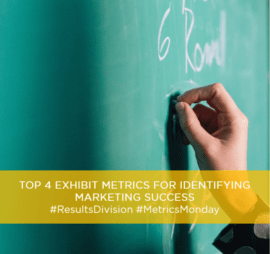Although many think that the purpose of a trade show is to get a broad array of product and services in front of a large number of people in one place with the use of custom trade show exhibits, the real value comes from the making contact and building relationships with individuals qualified to do business with your company. Thus, the target audience includes prospects, customers, suppliers or other participants in the profit equation of your business.
Marketing exists to create sales opportunities and to increase the probability of top-line revenue. In order to meet these objectives, your program must reach out to targets and persuade them to act for the benefit of your company. It is therefore essential to know and report who visited your venue and what outcomes are expected as a result of their experience in order to justify the value of an event marketing activity.
The four metrics that are critical to this process are:
- Who visited
- Why they came
- What they learned
- What your visitors plan to do as a result of their visit
There are a number of ways to determine these four metrics. A common practice is to conduct live, post-visit intercept surveys. They help you understand how well you connected with your targets. Intercept surveys provide accurate demographic profiling of visitors to your exhibit or event. This includes targeting criteria such as industry affiliation, company type, company size, individual responsibility, job title, buying readiness and purchase intent. Post-visit intercept surveys also identify what the participants learned (if anything) and most importantly, what they intend to do as a result of their visit. This data can even provide a forecast of expected sales driven from the participant’s view.
More sophisticated measures are possible using post-event survey techniques that pull from the entire event audience, which includes those who visited your exhibit or event as a subset. You can identify changes in purchase intent, brand preference, brand fit, and Net Promoter* scores, for example. These metrics help you understand about the effectiveness of your marketing activity in creating positive change in perceptions among your targets that would result in an increased probability of sales.
Another method is to utilize technologies such as localized scanning techniques that provide real-time visitor identification and tracking of their movement. Radio Frequency Identification (RFID) can provide real-time activity reports on session attendance, time on the show floor and in-booth activity by product interest and for post-event analysis.
Understanding what your visitors plan to do as a result of their visit is one of the most crucial elements. A qualified lead should be committed to take a pre-determined action that the sales team has defined as a step in the company’s sales cycle. A well-established definition of a qualified lead will provide a strong metric regarding actual sales opportunities.
There are many metrics that are important to exhibit and event managers. As far as Return on Investment (ROI) is concerned, determining who came, the persuasiveness of their experience and their intent to act provide the clearest measures of effectiveness. To learn more about ROI, particularly on trade shows, contact us today.
*Net Promoter Score – The Net Promoter Score is an index ranging from -100 to 100 that measures the willingness of customers to recommend a company’s products or services to others. It is used as a proxy for gauging the customer’s overall satisfaction with a company’s product or service and the customer’s loyalty to the brand.

